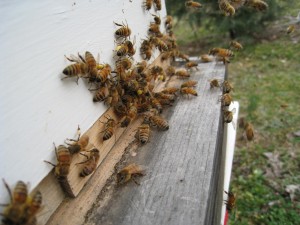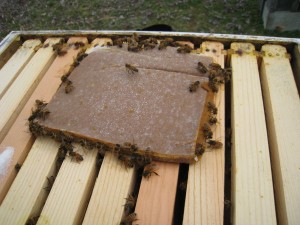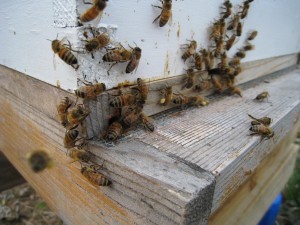
Both hives showed strong activity this weekend. There were tons of bees on the landing board and all on the front faces of both hives. It’s fun to watch them coming and going when they are active. They are really bringing in the pollen now, yellow’s, red’s and a beige color. I decided not to open them, as I am hopeful that they are moving up into the upper deeps. And this gets to the heart of my worries.
Having checked a few other blogs out in cyberspace and monitoring some forums, there are lots of folks to the north of me that have already done their reversals. Although the weak hive definitely had a barrier (tons of sugar water honey, making them honey-bound, above them), the stronger hive should have moved up. They have lots of empty, drawn comb above them.
Regardless, I have come to learn that there is no correlation between seeing something that I did not expect and the well being of my hives. Said another way, I am typically concerned for naught (and this has frequently driven me to do things that probably annoyed the bee’s at best and set them back at worst!) Even so, I am certain that it is past time for me to actually break the bottom deep’s open. As of now, I have only viewed them from above, since there is so much burr comb in their loose formation (see my earlier post on why this happened, as I cannot bear the pain of repeating my idiocies again!) So, this coming weekend is going to be a big one. As a reminder to myself, my plan is as follows:

- Open each hive and pray that there is some movement into the upper deep’s (by ‘movement’, I mean that I need to see queen activity up there). If I see it, I may wait another week or two before proceeding to the next step. For me, it is critical to locate both queens at this inspection. I have gone 6 months without seeing either of them.
- Remove each frame in the bottom deep and do a thorough inspection. Record honey, pollen and brood estimates.
- Check for any drone cells. It is my understanding that swarming begins when the drones first emerge. I do not expect to see any this early, but we all know how it goes with my expectations.
- Clean all frames of propolis and burr comb. This could get messy, so I hope to bring a little container along with me. I am going to clean up these frames. I might even smoke them for the first time this year if things get hairy.
- Clean the bottom deep of propolis and any stray wax.
- Take two of more of the oldest frames (the ones that came as part of the Nuc) and move them to the outside of the deep, for removal/replacement next year.
- Identify what frame the queen is on and make sure she is not on the bottom. Then, remove the bottom deep from the screened bottom board and replace with my painted, screened bottom board.
- Put them all back together.
Hopefully, this will all go well. The strong hive has had a big batch of sugar syrup and Honey-B-Healthy on them for a week now and they do not seem to have touched it. I think this is a positive sign, as they must be finding nectar out in the wilds (I noticed that my plum tree is blooming now.) This is little doubt that there are all kinds of surprises waiting for me, but here are some of the things that I might come across and my plans for dealing with them (I am trying to get these clear in my mind so that I have all of the necessary equipment on hand when I make this dive.)
- Swarm Queen Cells: If I find these, I will do a split. I will move the old queen, a frame of brood and a frame or two of honey to a Nuc. If I have more then one frame with a queen cell on it, I might take one of the spare queen cells and also drop it into a Nuc. I purchased two Nuc’s this year for this exact reason. I honestly hope that I do not have to use them…
- Supercedure Queen Cells: If the weak hive is getting ready to start a rebellion, I will let them do it. The hive looks strong right now, but they tried to get rid of her last Fall (but I stopped them – or I think I did!). If more then one frame has a queen cell on it, I will pull it and drop it into a Nuc with a couple of frames of honey.
- Lots o’ Honey: If the weak hive still has 7+ frames of capped honey, I will take 3 frames of this and put it in the freezer. I will take a frame or two of drawn comb from the stronger hive (putting in foundation here) and drop it into the center of the weaker hive. The goal here is to create some brood-rearing space.
For my Nuc’s, I will use the honey frames from the weak hive. Unless things have changed, I will probably have a ton of them left over. But, who knows what I will find. If my course remains true to form, I will find none of the above and instead something totally odd.

